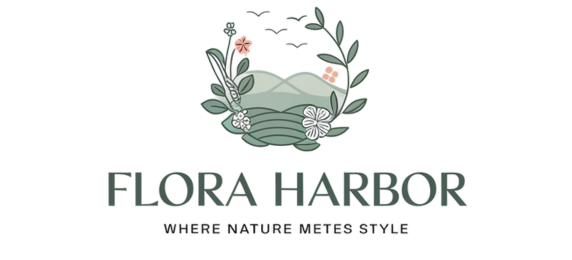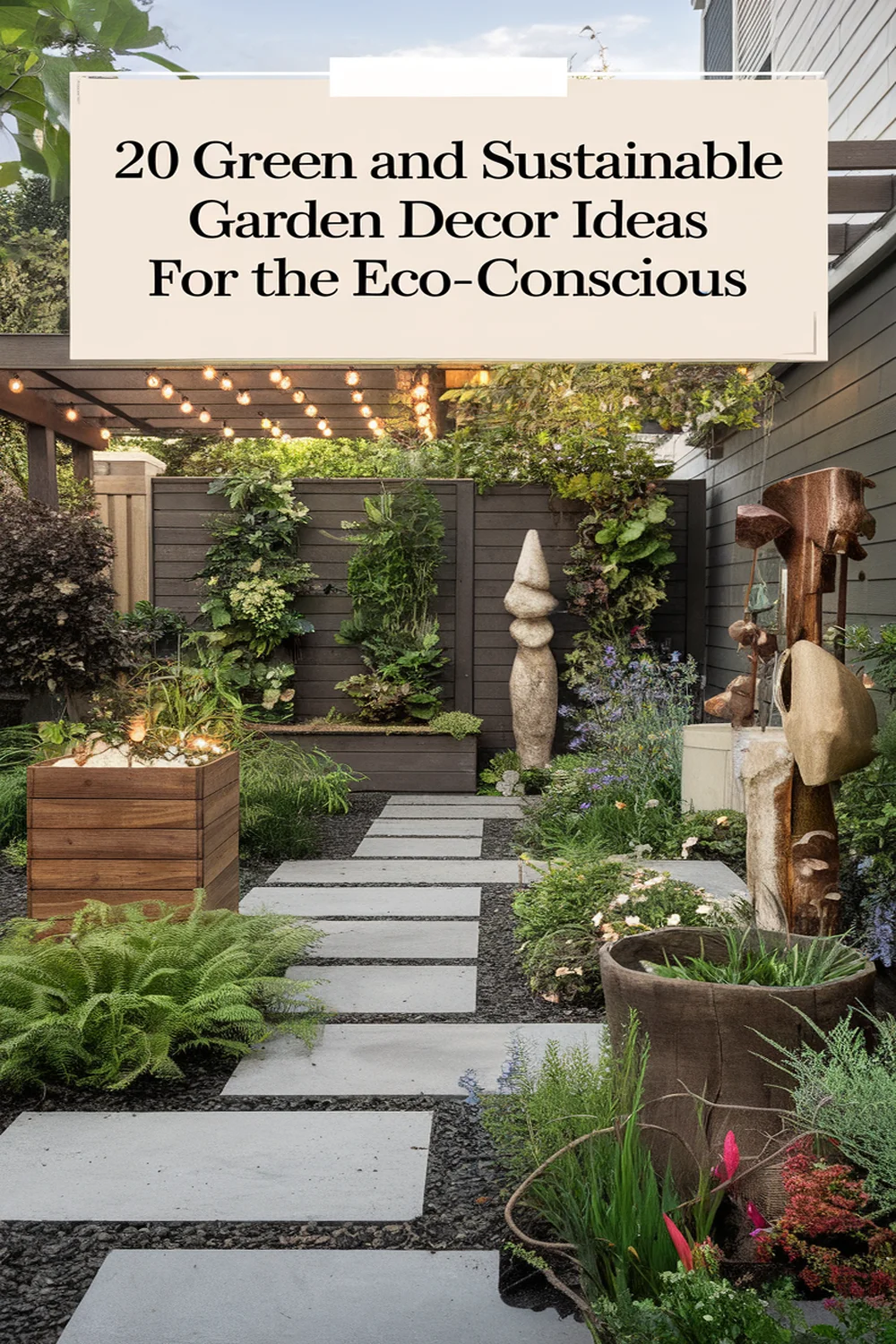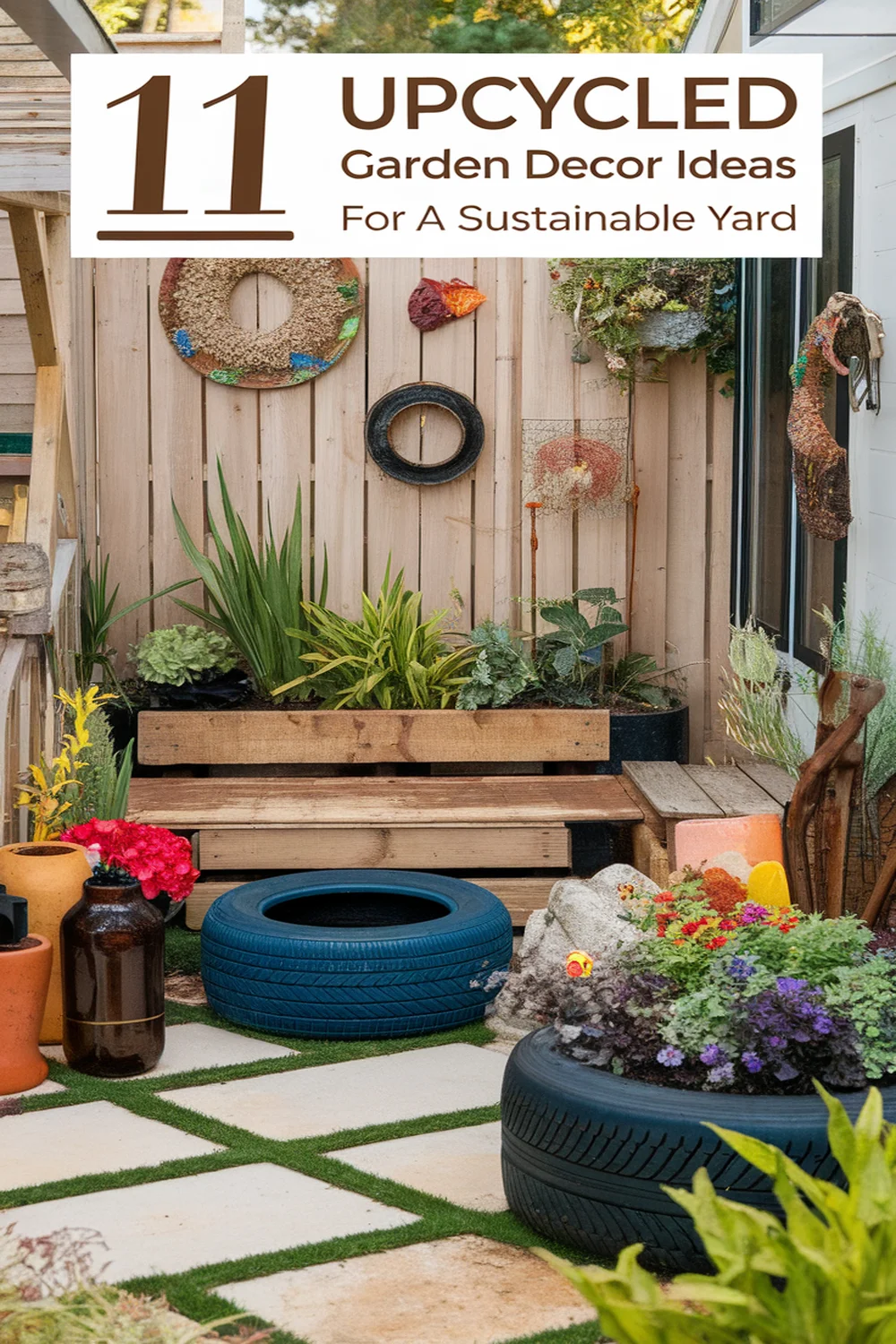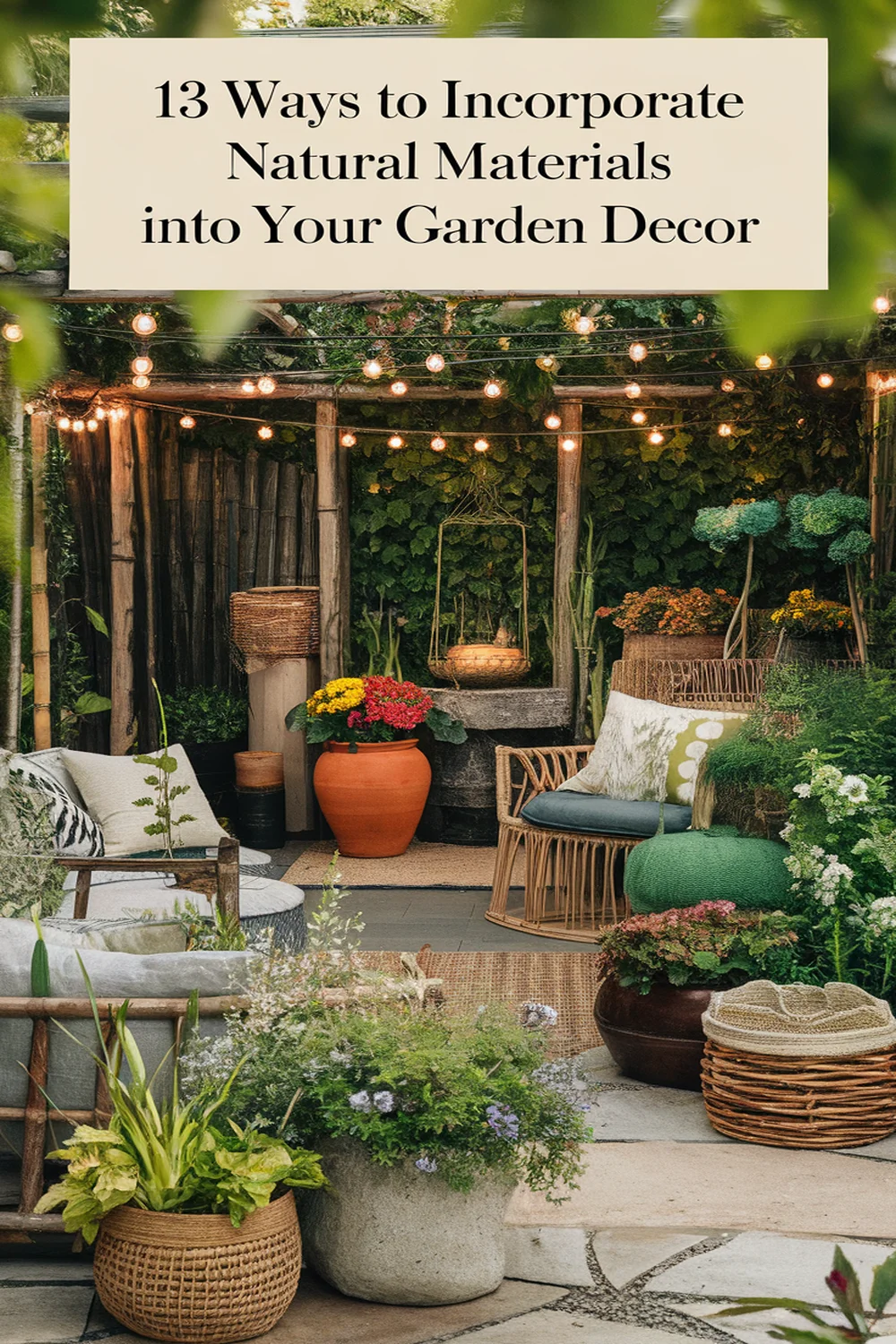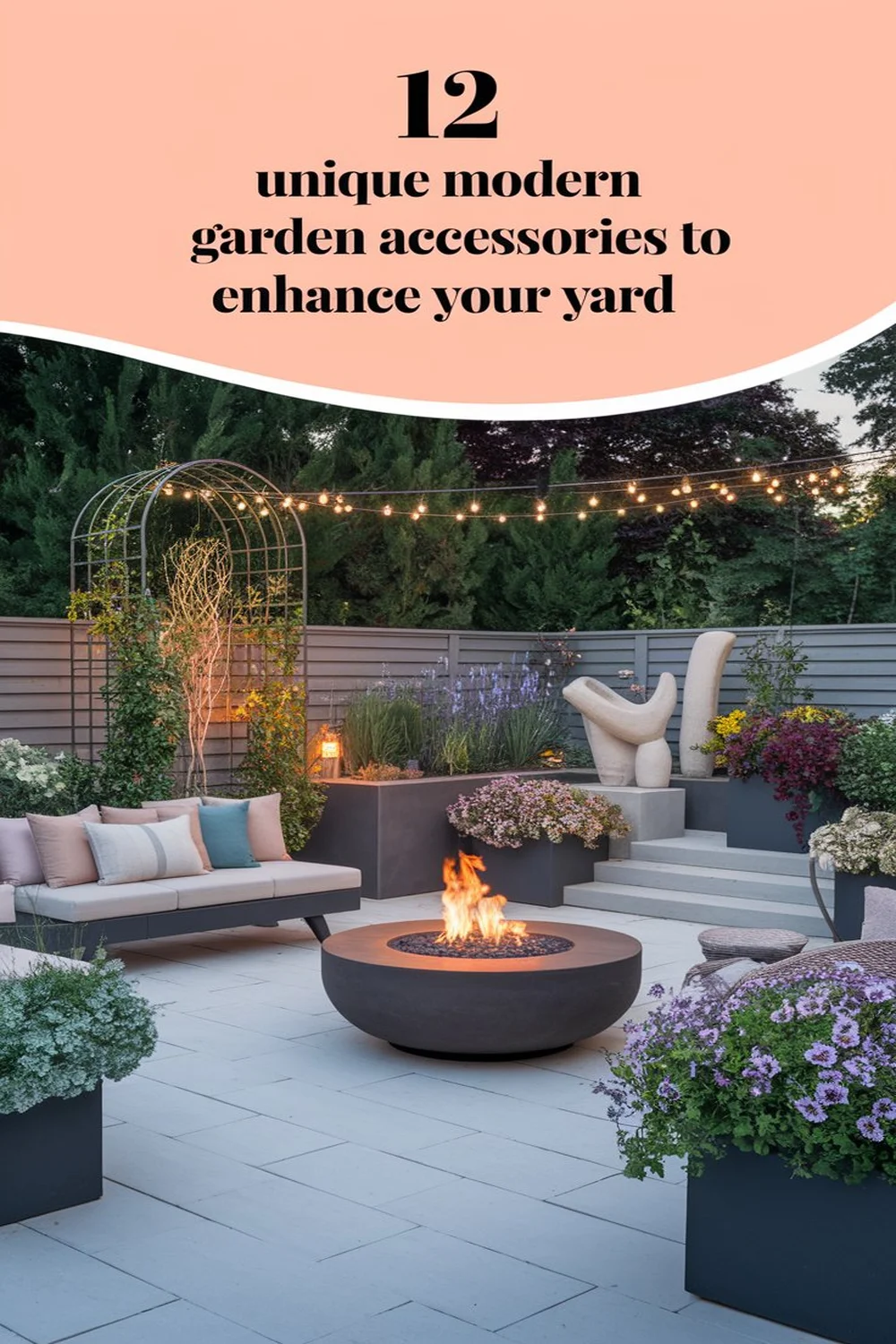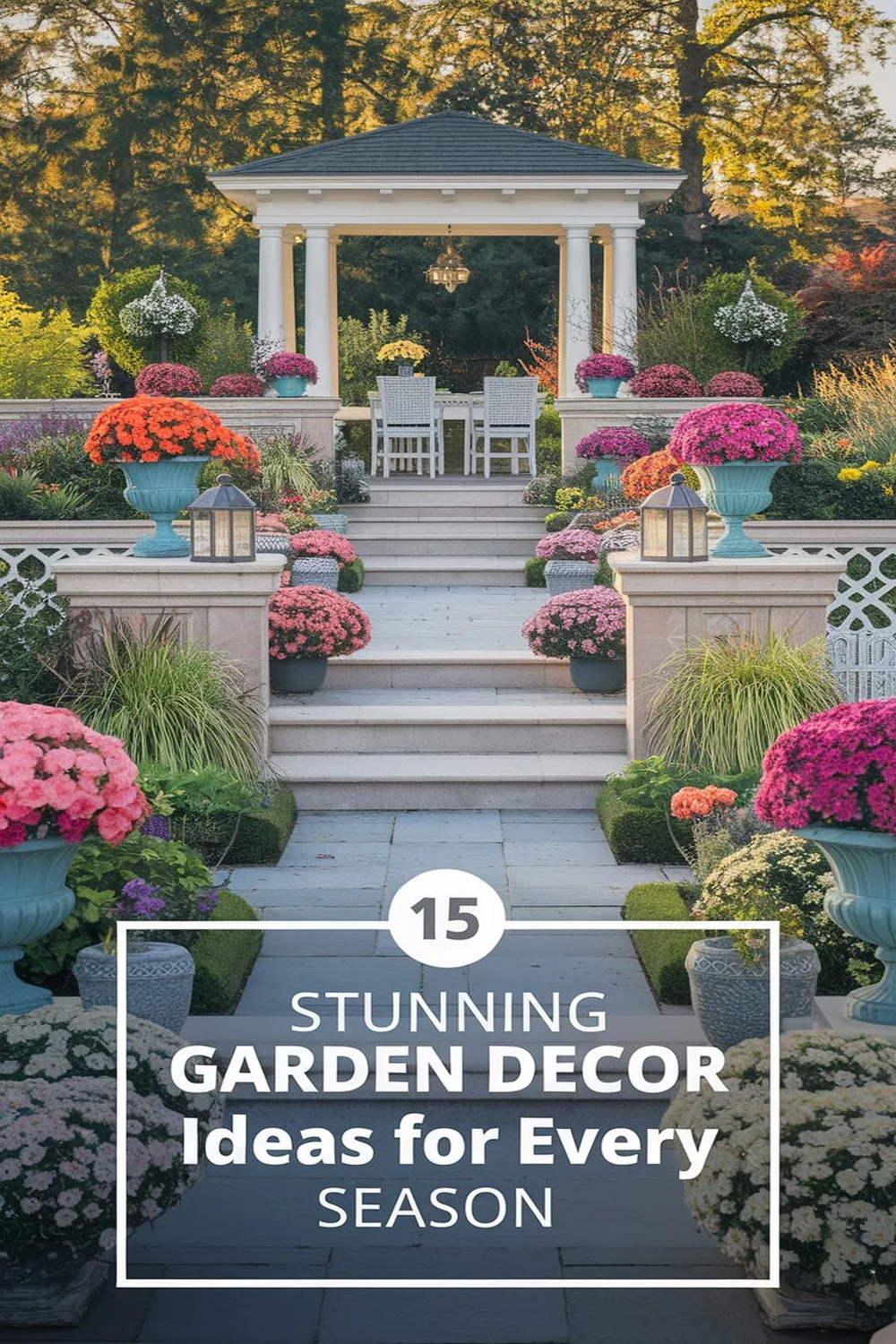This post may contain affiliate links. Please read our policy page.
Transform your garden with eco-friendly decor that’s both beautiful and sustainable! Upcycle old containers into planters, build compost bins from pallets, and harvest rainwater for irrigation. Incorporate native plants to attract local wildlife while reducing maintenance. Create stunning glass art from recycled materials and use thrifted decor for a unique touch. Combine these ideas with well-crafted signage made from repurposed materials to enhance your garden’s aesthetics. Discover even more innovative solutions to elevate your green space!
Upcycled Planters From Old Containers
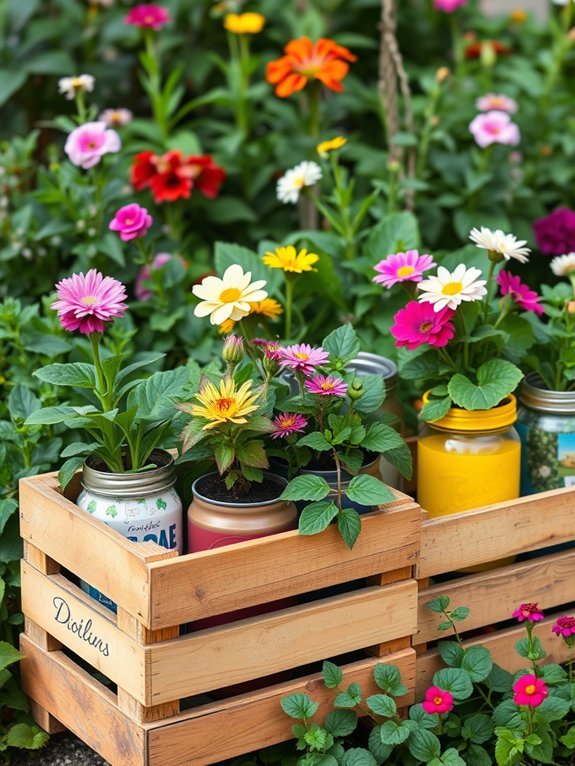
Transforming old containers into upcycled planters is an exciting way to green your garden and reduce waste. You can breathe new life into unwanted items like tin cans, glass jars, or old boots by converting them into unique planters. Ascertain proper drainage by adding holes to the bottom of each container. Consider using eco-friendly soil and native plants that thrive in your region, promoting biodiversity. This practice not only beautifies your space but also minimizes landfill waste. Additionally, it allows you to customize your garden decor, reflecting your personal style. With a bit of creativity, you can create a vibrant sanctuary that’s both sustainable and visually appealing, encouraging others to adopt eco-conscious habits in their gardening pursuits.
Compost Bins Made From Pallets

Creating a compost bin from wooden pallets is a practical and eco-friendly solution for managing kitchen scraps and yard waste. This DIY project not only helps reduce landfill waste but also enriches your garden soil. To get started, follow these simple steps:
- Gather Materials: Find three to four pallets in good condition.
- Choose a Location: Pick a well-drained, sunny spot in your garden.
- Assemble the Bin: Stand the pallets upright to form a square or rectangle, securing them with screws or brackets.
- Add Compostable Waste: Start adding organic matter like fruit peels, vegetable scraps, and grass clippings.
Recommended Items
Here are our recommended products and equipment to create your sustainable garden—feel free to explore!
Rainwater Harvesting Systems
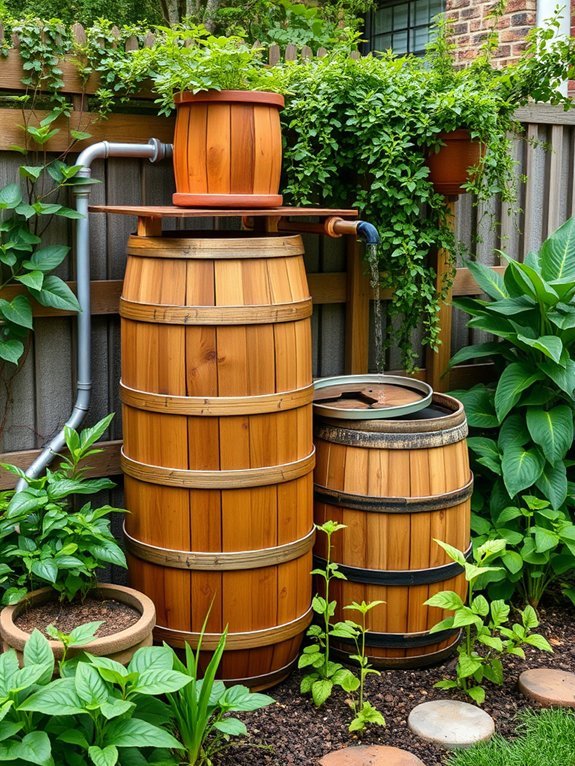
While you might not realize it, harvesting rainwater can substantially reduce your water bill and provide an eco-friendly way to keep your garden thriving. By collecting rainwater from your roof through gutters and downspouts, you create a sustainable solution for irrigation. Installing a rain barrel is a practical first step. They come in various sizes and can be placed near your vegetable beds or flower gardens. Aim for a system that includes a filtration mesh to prevent debris, ensuring clean water for your plants. You can also consider connecting multiple barrels for greater capacity. Remember to check local regulations, as some areas may have guidelines for rainwater harvesting, ensuring you’re compliant while nurturing your eco-conscious garden.
Native Plant Gardens

If you’re looking to enhance biodiversity and minimize maintenance in your garden, consider incorporating native plants into your landscape. These plants are adapted to your local environment, requiring less water and fertilizers. Here’s why you should choose native plants:
- Attract Pollinators: Native plants support local bees, butterflies, and birds, fostering a thriving ecosystem.
- Reduce Water Use: They typically need less irrigation, making watering more efficient.
- Support Local Wildlife: Native species provide food and habitat for various wildlife, boosting local biodiversity.
- Low Maintenance: Once established, native plants require minimal care, letting you enjoy your garden without constant upkeep.
Recycled Glass Garden Art
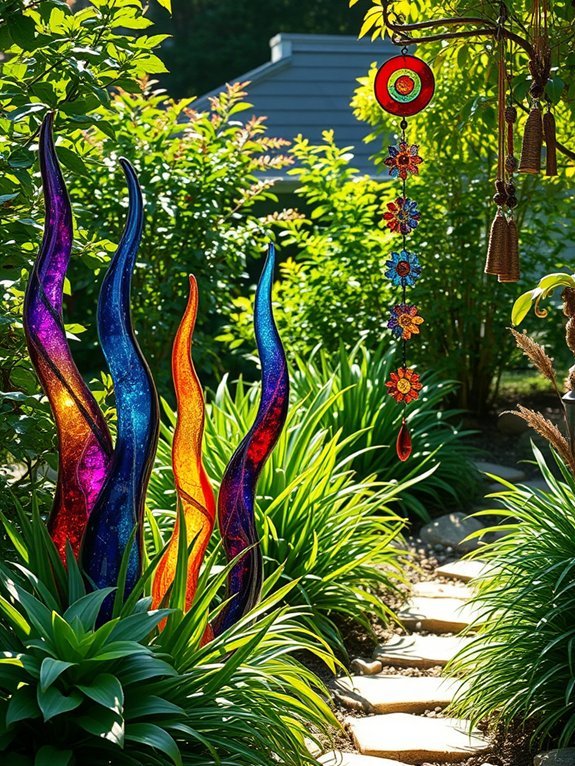
By incorporating recycled glass into your garden decor, you not only enhance its visual appeal but also contribute to environmental sustainability. Using materials like crushed glass, bottles, or even glass ornaments can create stunning focal points without harming the planet. Consider crafting colorful mosaics or using glass shards in pathways to add a unique touch. You can repurpose old bottles as planters or make hanging garden art that catches the light beautifully. Additionally, choose weatherproof, UV-resistant glass to guarantee your creations last. This type of art supports a circular economy by keeping glass out of landfills. As you design, remember to embrace vibrant colors and shapes, which can transform your garden into a breathtaking oasis while remaining eco-conscious.
DIY Bird Feeders From Reclaimed Wood
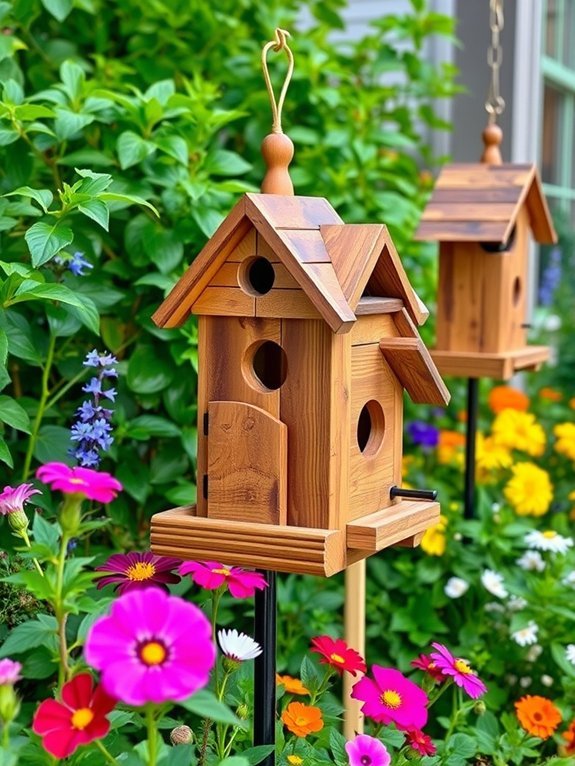
Creating DIY bird feeders from reclaimed wood not only provides a sustainable snack station for your feathered friends but also gives a second life to materials that might otherwise go to waste. By undertaking this eco-friendly project, you can contribute to bird conservation and enjoy watching your backyard visitors thrive.
Here’s how to start:
- Collect materials: Gather old wooden pallets or scraps from home improvement projects.
- Plan your design: Sketch your feeder style, whether a simple platform or a hanging design.
- Assemble and secure: Use non-toxic wood glue or screws to guarantee durability.
- Finish and fill: Sand rough edges for bird safety, then fill with seeds or nuts.
Enjoy the colorful visitors while promoting sustainability!
Edible Landscaping With Herbs and Vegetables
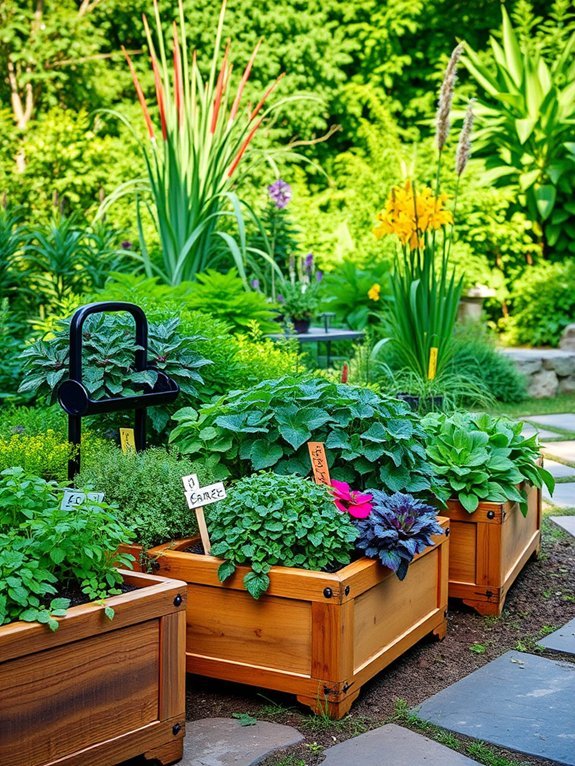
Transforming your garden into an edible landscape filled with herbs and vegetables offers a sustainable way to enhance both your outdoor space and your meals. By integrating these plants into your existing decor, you can create a vibrant, functional garden. Here are some popular options:
| Herb/Vegetable | Benefits |
|---|---|
| Basil | Enhances flavor in dishes |
| Rosemary | Attracts pollinators |
| Tomatoes | Provides fresh produce |
| Spinach | Nutrient-rich superfood |
| Kale | Hardy and versatile |
Growing your own herbs and vegetables reduces carbon footprints and reliance on store-bought products. Plus, nothing beats the taste of fresh ingredients! Start small, and watch your eco-friendly garden flourish while supplying your home with healthy additions.
Solar-Powered Garden Lights
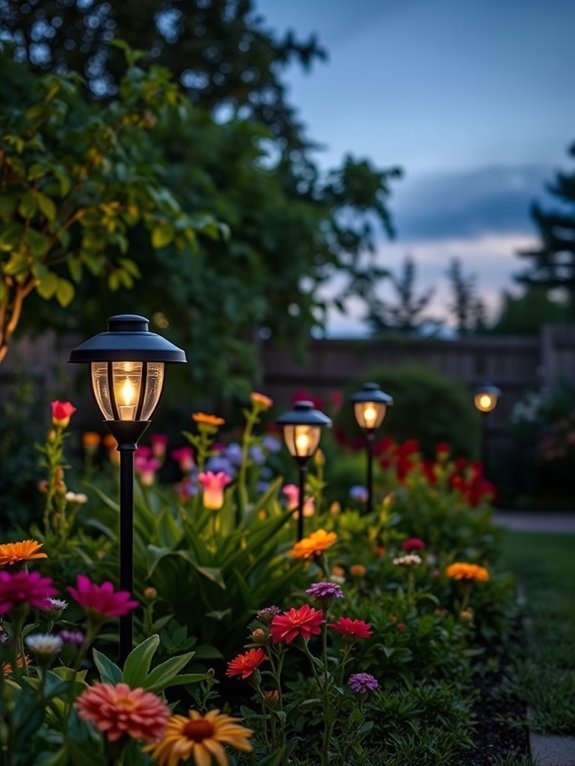
When you want to illuminate your garden sustainably, solar-powered garden lights are an excellent choice. These eco-friendly options harness the sun’s energy, providing light without increasing your electricity bill. Plus, they come in various styles to complement your garden’s aesthetic. Here are four reasons to weigh them:
- Energy Efficiency: They convert sunlight into energy, reducing your carbon footprint.
- Low Maintenance: Most models are weather-resistant and require minimal upkeep.
- Easy Installation: You just stake them into the ground, and you’re set.
- Versatility: Use them along pathways, highlight features, or create cozy seating areas.
Mulching With Recycled Materials

Mulching with recycled materials not only helps your garden thrive but also contributes to a more sustainable environment. You can use items like shredded cardboard, newspapers, or even coffee grounds to create effective mulches. These materials are abundant, affordable, and manage to suppress weeds while retaining moisture in the soil. Additionally, they break down over time, enriching the soil with organic matter. When you choose to mulch with recycled materials, you reduce waste and give new life to otherwise discarded items. Keep in mind to avoid glossy papers or treated materials, as they may contain harmful chemicals. Embrace this eco-friendly practice, and you’ll notice healthier plants and a safer environment for you and your garden.
Eco-Friendly Pathways Using Stones
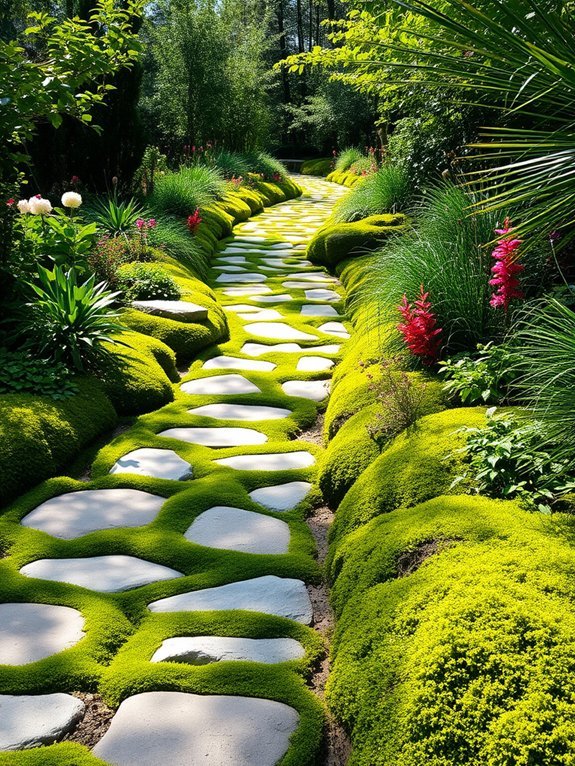
Creating eco-friendly pathways using stones not only enhances your garden’s aesthetics but also fosters sustainability. By choosing natural, locally-sourced stones, you minimize your ecological footprint. Here’s how to craft your perfect stone pathway:
- Select Native Stones: Use rocks and gravel native to your area; they blend naturally into the landscape.
- Design for Drainage: Guarantee your pathway has a slight slope to manage rainwater effectively, preventing erosion.
- Incorporate Ground Cover: Fill gaps with native plants or low-maintenance ground cover to support local biodiversity.
- Opt for Reclaimed Materials: Consider using reclaimed bricks or cobblestones for a unique touch that maintains environmental integrity.
With these steps, you’ll create a functional, beautiful walkway that respects nature’s resources.
Living Walls With Succulents
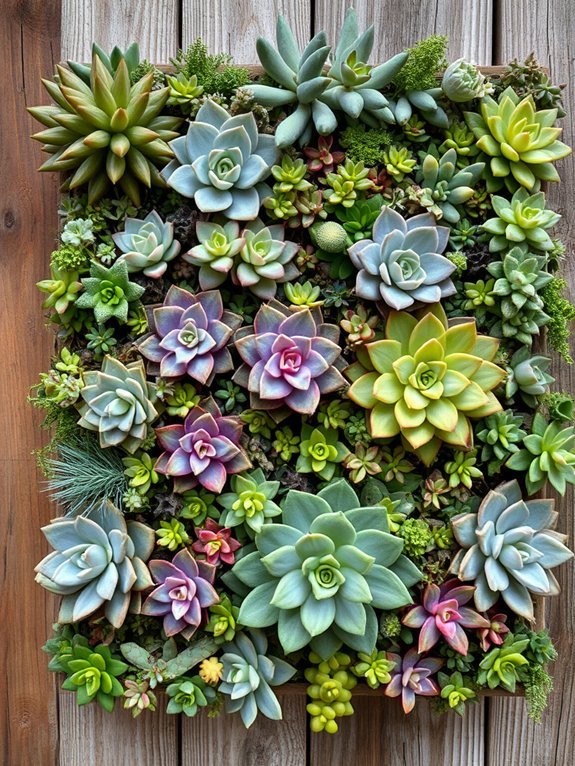
If you’re looking to elevate your garden while promoting sustainability, living walls adorned with succulents provide a striking and eco-friendly solution. These vertical gardens use minimal space and can reduce your carbon footprint by improving air quality. Succulents thrive on less water and require minimal maintenance, making them ideal for busy gardeners.
To create your living wall, select a sturdy frame or trellis, fill it with lightweight materials, and choose varying succulent types for visual interest. Position it where it gets ample sunlight, and water only when necessary to conserve resources. Living walls not only enhance the aesthetic of your space but also offer numerous environmental benefits, making them a perfect choice for eco-conscious gardening enthusiasts.
Handmade Garden Furniture From Reclaimed Wood
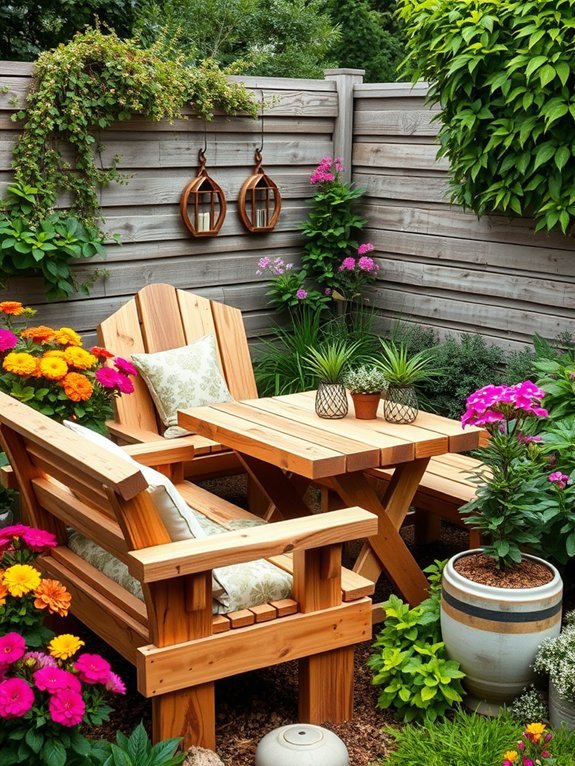
Building on your eco-conscious garden efforts, handmade garden furniture crafted from reclaimed wood brings both charm and sustainability to your outdoor space. Not only does it reduce waste, but it also adds a unique touch to your backyard. Here are some practical ideas for incorporating reclaimed wood furniture:
- Benches: Create a rustic seating area that invites relaxation.
- Tables: A reclaimed wood table becomes a focal point for outdoor dining.
- Planters: Use hefty wooden crates as raised beds or decorative planters.
- Decorative Accessories: Crafting wind chimes or lanterns from scraps enhances your space.
With these options, you’re contributing to a healthier planet while reveling in the character and beauty of handmade pieces. It’s a win-win!
Insect Hotels for Pollinator Support
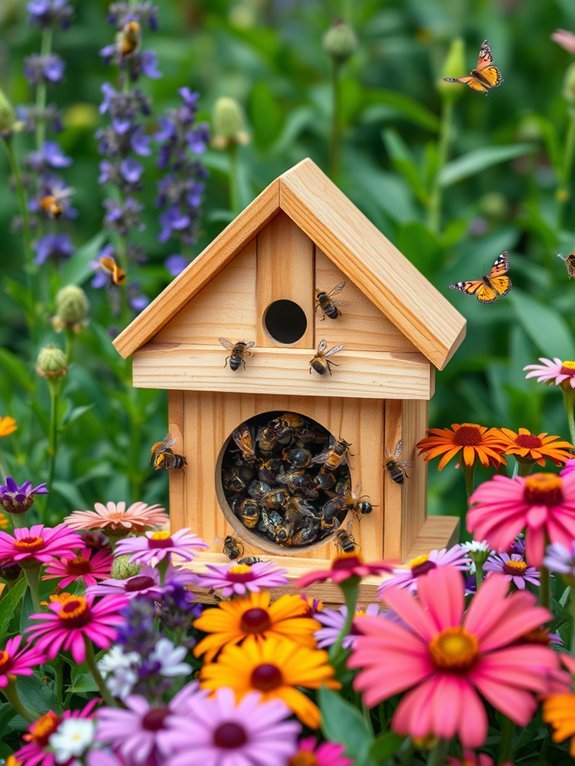
As you cultivate your eco-conscious garden, consider adding insect hotels to support local pollinators. These structures provide shelter and nesting sites for beneficial insects like bees, butterflies, and ladybugs. You can create your own hotel using natural materials such as bamboo tubes, dried plant stems, or wooden blocks with drilled holes. Position it in a sunny spot, away from strong winds, to maximize its effectiveness. By incorporating insect hotels, you encourage biodiversity and enhance your garden’s resilience. As pollinators thrive, they’ll increase your garden’s productivity by improving fruit and vegetable yields. Just remember to maintain them seasonally, ensuring they remain clean and hospitable for your tiny allies, creating a sustainable eco-system for everyone to enjoy.
Natural Pest Control Solutions
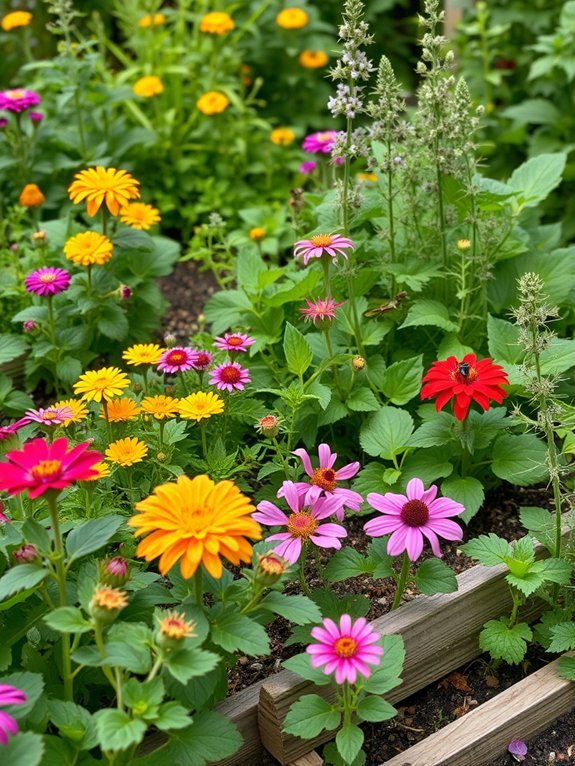
While chemical pesticides can harm the environment and disrupt local ecosystems, natural pest control solutions offer effective alternatives that keep your garden healthy and thriving. By using these eco-friendly methods, you can protect your plants without compromising the planet. Here are four practical solutions:
- Neem Oil: This natural pesticide disrupts pests’ life cycles and deters even the most stubborn bugs.
- Diatomaceous Earth: Sprinkle this fine powder around your plants; it’s lethal to soft-bodied insects.
- Companion Planting: Plant repellent species like marigolds alongside vulnerable crops to keep pests at bay.
- Beneficial Insects: Introduce ladybugs or lacewings to your garden—they feast on harmful pests.
Utilizing these solutions will help you maintain a harmonious garden environment!
Compost Tea for Fertilizing
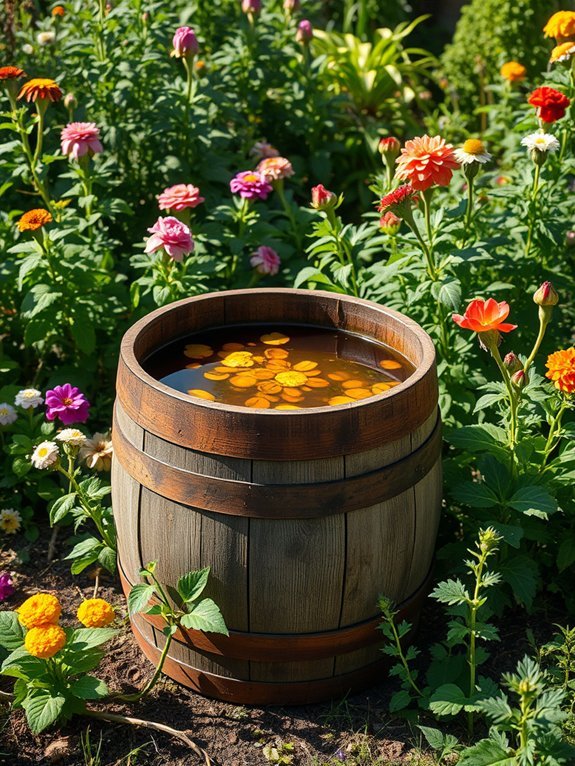
Compost tea is a powerful, eco-friendly fertilizer that can supercharge your garden’s health and productivity. By steeping finished compost in water, you create a nutrient-rich liquid that delivers essential microbes and nutrients directly to your plants. It not only boosts plant growth but also improves soil structure and fertility.
To make your own compost tea, simply fill a burlap bag with mature compost, submerge it in a 5-gallon bucket of non-chlorinated water, and let it steep for 24 to 48 hours. Stir occasionally, then strain out the solids. Use the liquid to water your garden, ideally during cooler hours to minimize evaporation. Regular application can lead to vibrant, healthy plants while minimizing synthetic fertilizer use.
Vertical Gardens Using Upcycled Materials
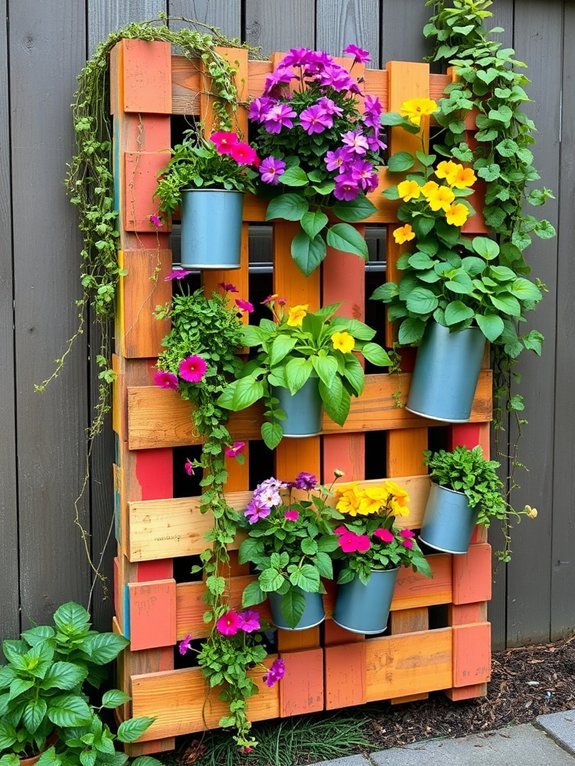
Using compost tea can greatly enhance the health of your garden, but there are other innovative ways to maximize your space and sustainability, like vertical gardens made from upcycled materials. These gardens not only save space but also turn waste into beauty! Here are some ideas to get you started:
- Plastic Bottles: Cut and stack them for a unique wall garden.
- Wood Pallets: Prop them vertically and fill with soil for a rustic look.
- Old Shoes: Use them as quirky planters for herbs or flowers.
- Cans: Paint and attach them to a fence for an artistic display.
These options are practical, eco-friendly, and will inspire your creativity while reducing waste.
Seed Bombs for Wildflower Growth
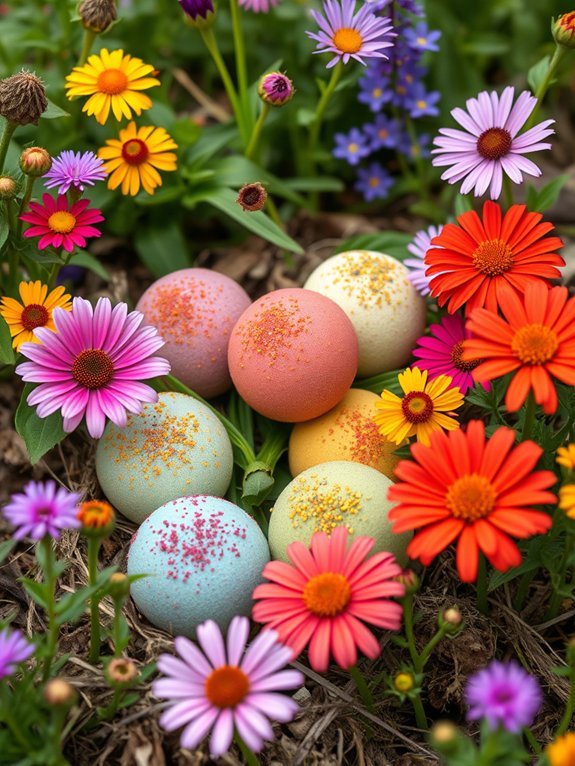
Seed bombs are a simple yet effective way to encourage wildflower growth in your garden or community. These compact balls of soil, clay, and seeds make it easy to disperse native plants, enhancing biodiversity and supporting local ecosystems. You can create your own seed bombs using native wildflower seeds and organic materials. Just mix the ingredients, roll them into small balls, and let them dry.
Here’s a quick glance at essential components:
| Ingredient | Purpose |
|---|---|
| Seed | Initiates wildflower growth |
| Clay | Binds materials together |
| Compost or Soil | Provides nutrients and moisture |
Thrifted or Vintage Garden Decor
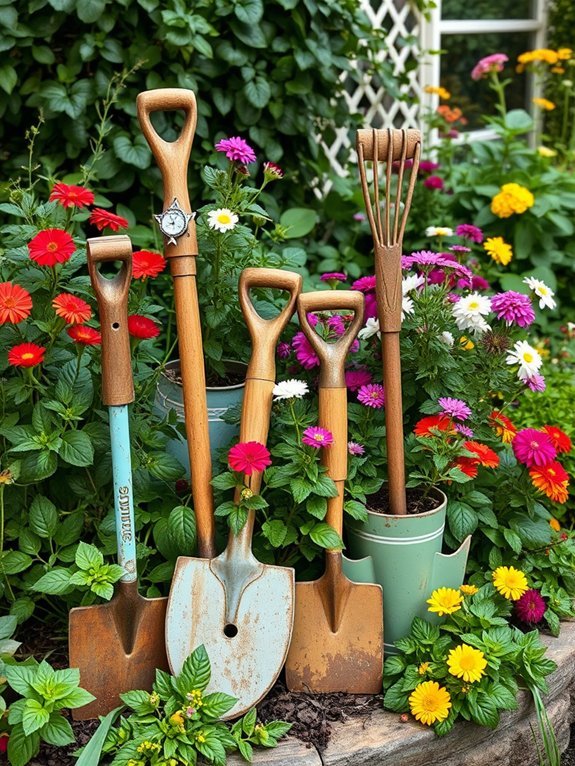
Incorporating thrifted or vintage garden decor can transform your outdoor space while promoting sustainability. By reusing and recycling items, you reduce waste and add character to your garden. Here are four ideas to get you started:
- Repurposed Furniture: Use old chairs or tables as quirky plant stands or seating.
- Vintage Planters: Look for unique containers, such as teacups or old crates, to house your plants.
- Garden Art: Search for old tools or utensils to create unique sculptures and ornaments.
- Antique Accessories: Incorporate items like lanterns or birdcages to offer a nostalgic touch.
With a little creativity, thrifted decor not only enhances beauty but also champions eco-conscious living. Happy hunting!
Project Plan for Eco-Friendly Garden Decor
Wildlife-Friendly Native Plant Borders
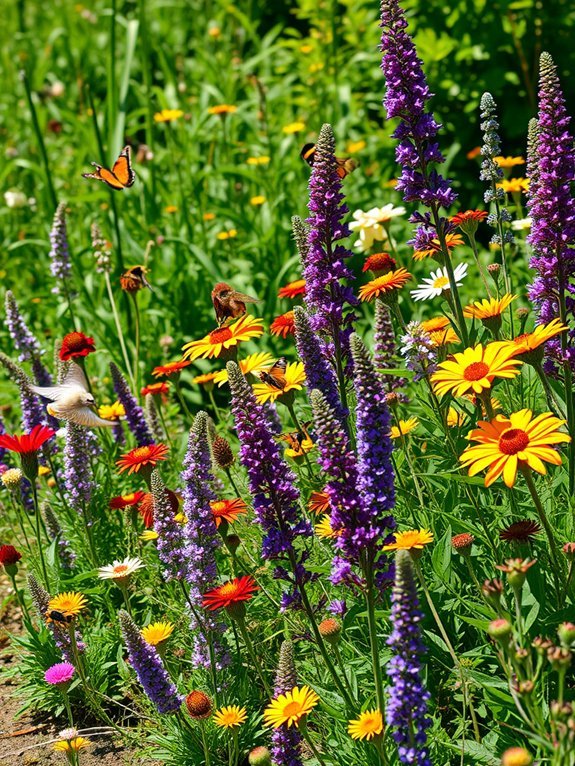
While exploring thrifted garden decor adds charm and character to your outdoor space, creating wildlife-friendly native plant borders enhances the ecosystem in your garden. By choosing plants native to your region, you support local wildlife, including bees, butterflies, and birds. These species thrive on the unique nectar and seeds native plants provide. Start by selecting a variety of flowering plants, grasses, and shrubs that suit your soil and light conditions. Grouping plants in clusters encourages pollinator visits. Additionally, native plants require less water and fewer chemicals, making them low-maintenance and eco-friendly options. You’ll not only beautify your space but also play a vital role in preserving biodiversity. Your garden can become a welcoming habitat for wildlife while enriching your landscape.
Sustainable Garden Signage From Recycled Materials
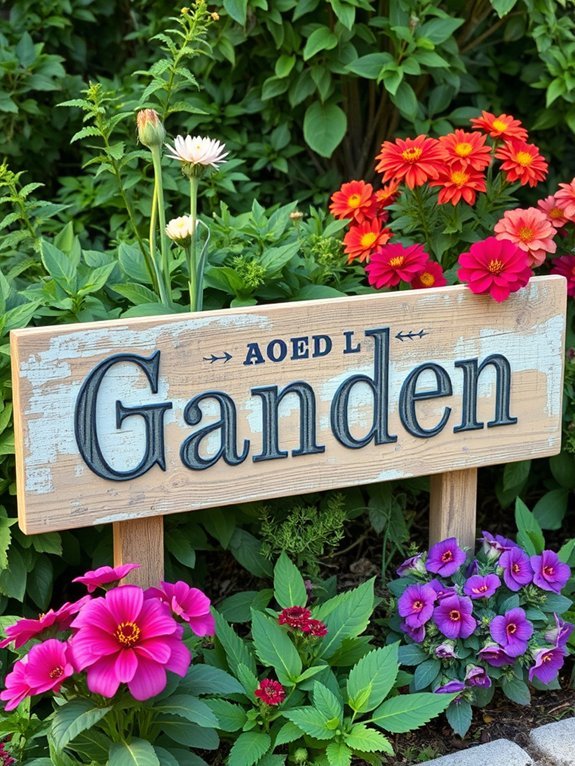
Garden signage can considerably enhance the functionality and aesthetics of your outdoor space, all while promoting sustainability. By creating signs from recycled materials, you not only reduce waste but also add a unique touch to your garden. Here are four practical ideas to inspire your eco-friendly signage:
- Wooden Pallets: Repurpose old pallets into beautiful directional signs or plant markers.
- Tin Cans: Clean and paint used tin cans for charming, weather-resistant labels.
- Glass Bottles: Use cut glass bottles to create artistic markers for pathways or garden beds.
- Cardboard: Securely coat cardboard pieces with natural weatherproofing to create temporary signs.
These options demonstrate that sustainable garden signage is both practical and visually appealing.
